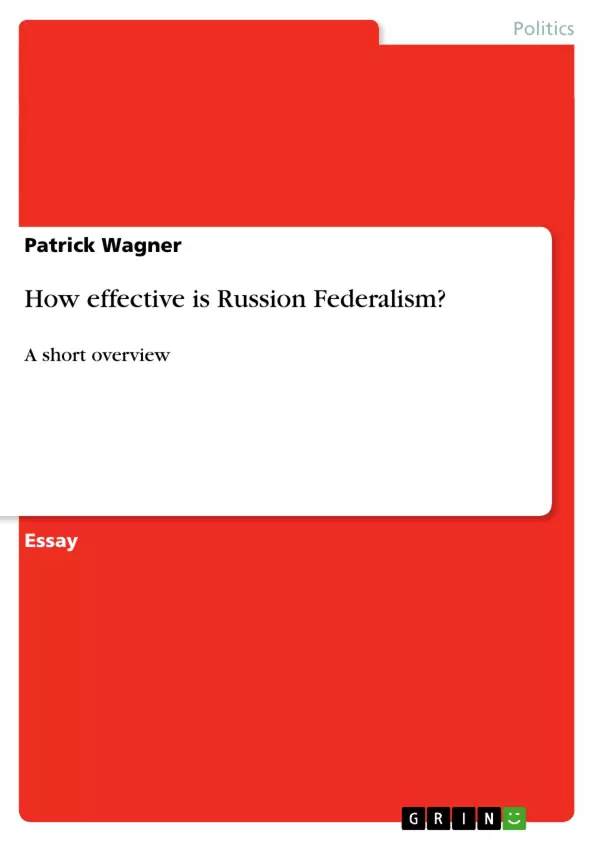Nowadays federalism is a widely used concept for organising states around the world. Although, genuinely federal systems can only be found in a minority of states, one can observe a trend towards regionalism and local self-government in many countries. A main principle of the EU, for example, is to give the regions within its member states as much power as possible – this means government at the lowest possible level. Even traditionally unitary states like Britain now allows regional parliaments. The state as a unitary entity, although not everywhere, seems to have lost its ability to unite a country. People believe that regional problems are best dealt with at a regional level rather than from a central government.
Especially states with a very large territory seem to be prone to be organised in a federal way. Here, federalism is a guarantor of stability and integration, as a large territory usually includes many different ethnic groups and regions which claim a certain amount of independence within the state. Russia would thus perfectly fit into this pattern and one could think that federalism has a long tradition. However, the history is different: the Russian Empire under the Tsars was organised centrally and although the USSR claimed to be federal, regional politics was determined by Moscow.
The fall of communism was used by many Soviet republics to gain independence. Those who stayed in the Russian Federation were given at least cultural independence, but linked to loyalty to Russia. Yeltsin’s 1993 Constitution was the result of long struggles and bargaining about the degree of autonomy for the republics. Finally, the word ‘autonomy’ was not used to describe their status but the republics were allowed to have their own constitution, national flag and president. This was then probably the highest degree of sovereignty, the republics have had for the last 100 years.
Before engaging into a discussion on the effectiveness of Russian Federalism, this paper will firstly define Federalism in general and establish what is so special about the Russian federalism. Secondly, the problems with the present system shall be mentioned and recent attempts by President Putin to solve these problems shall be looked at.
Inhaltsverzeichnis (Table of Contents)
- How effective is Russian federalism?
- Federalism and its special characteristics in Russia
- What makes federalism distinct from a unitary system?
- The nature of federalism and its impact on society
- Federalism as a means of balancing national and regional interests
- The significance of bicameral legislative systems in federal states
- Germany: A case study of federalism in practice
- The Evolution of Federalism in Russia
- The Soviet Union: A facade of federalism?
- The collapse of the Soviet Union and the emergence of a new federation
- Yeltsin's approach to federalism and the rise of regional autonomy
- The challenges of maintaining federalism in Russia
- The impact of population decline and territorial issues on Russian federalism
Zielsetzung und Themenschwerpunkte (Objectives and Key Themes)
This essay examines the effectiveness of Russian federalism by first defining federalism in general and then exploring the unique characteristics of the Russian federal system. It analyzes the challenges faced by the system, specifically those stemming from the collapse of the Soviet Union and the subsequent push for regional autonomy. The essay aims to provide insights into the successes and limitations of Russian federalism, highlighting key issues related to regional power, national unity, and the stability of the Russian Federation.
- The nature of federalism and its distinctive features
- The evolution of federalism in Russia, from the Soviet era to the post-communist period
- The relationship between federalism, regional autonomy, and national unity in Russia
- The challenges posed by population decline, territorial issues, and regional power dynamics
- The effectiveness of Russian federalism in promoting stability and integration
Zusammenfassung der Kapitel (Chapter Summaries)
The essay begins by outlining the key characteristics of federalism, distinguishing it from unitary systems and emphasizing the role of checks and balances in federal governance. It uses Germany as an illustrative example of a country with a long tradition of successful federalism. The essay then delves into the history of federalism in Russia, arguing that the Soviet Union's system was not truly federal. The collapse of the USSR led to the formation of a new Russian Federation with a system of regional autonomy that aimed to balance national interests with those of the republics.
The essay discusses the challenges faced by Russian federalism, including the loss of population, territorial issues, and the power dynamics between regional leaders and the central government. It analyzes Yeltsin's approach to federalism and the consequences of his efforts to maintain unity in the face of regional aspirations for greater autonomy. The essay concludes by emphasizing the importance of understanding the historical context of Russian federalism and the ongoing struggle to balance national and regional interests.
Schlüsselwörter (Keywords)
This essay examines key concepts such as federalism, regional autonomy, national unity, and the challenges of balancing power between the center and regions. It explores the historical evolution of federalism in Russia, from the Soviet era to the post-communist period, with a particular focus on the relationship between federalism, regional autonomy, and the stability of the Russian Federation. The essay also considers the impact of population decline and territorial issues on the effectiveness of Russian federalism.
- Quote paper
- Patrick Wagner (Author), 2002, How effective is Russion Federalism?, Munich, GRIN Verlag, https://www.grin.com/document/18951



